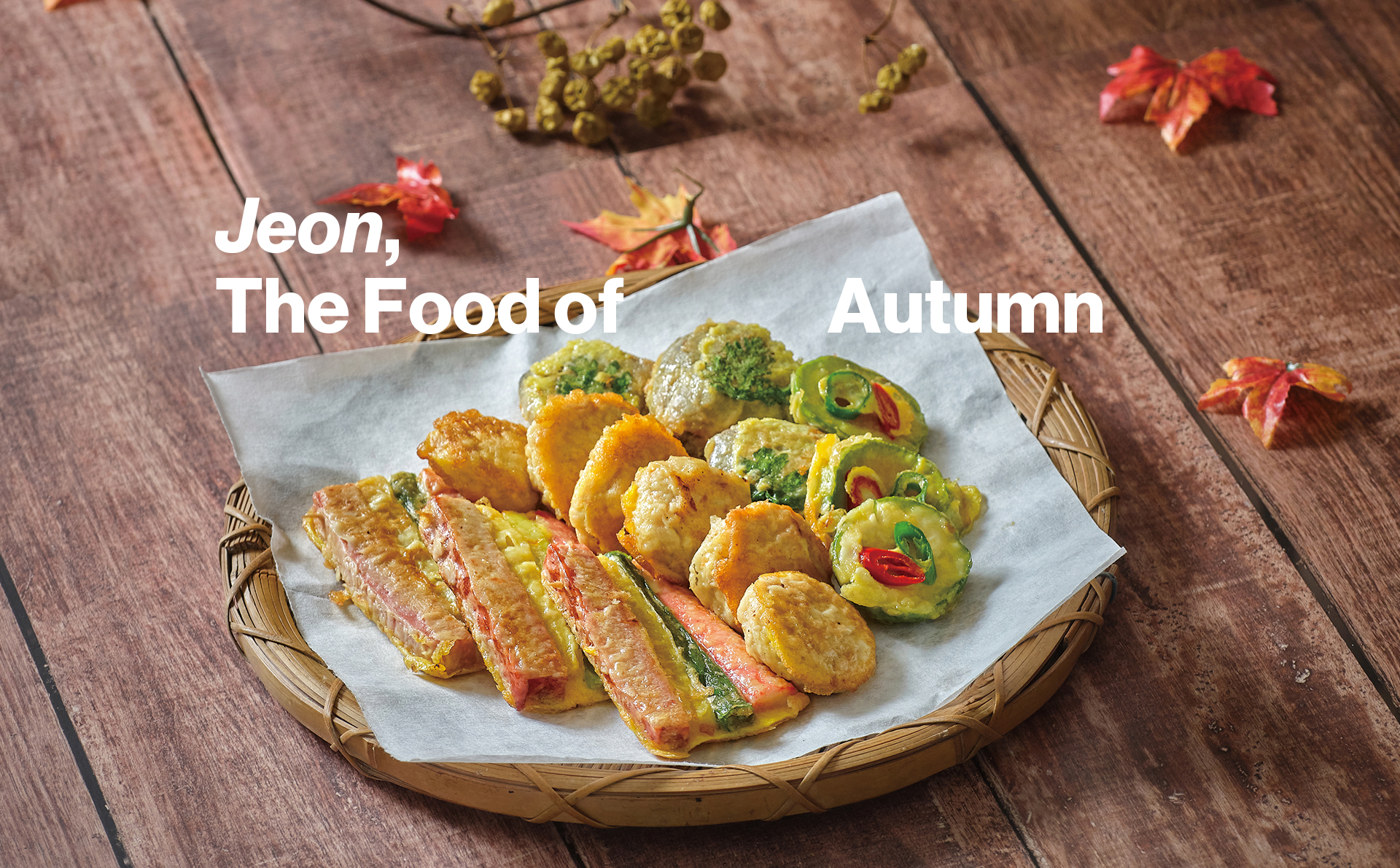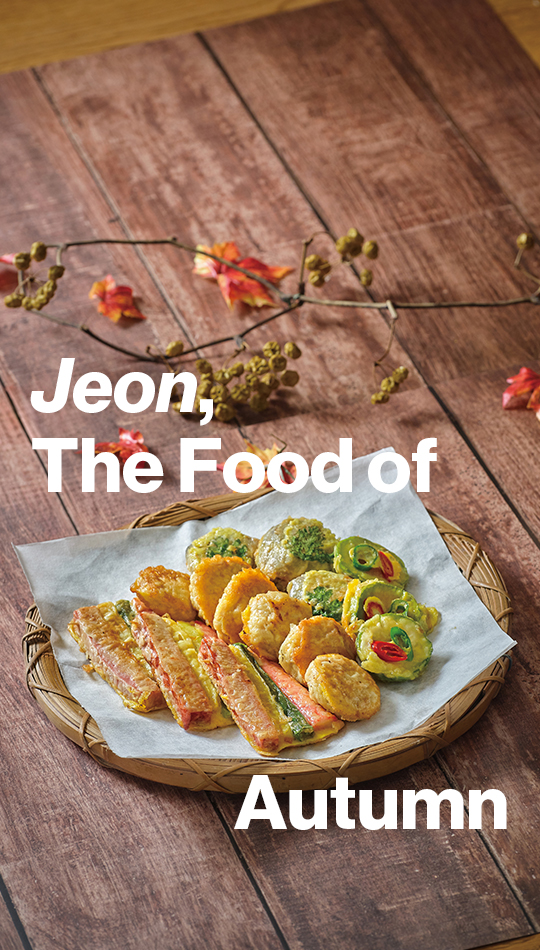Korea has its most significant holiday, Chuseok, in September, when the heat subsides and the cool breeze begins to blow. The holiday celebrates harvesting the fruits of farming, such as different kinds of grains. People offer prayers for a good harvest in the future. Most Koreans think of jeon when this day comes. Jeon is made with wheat flour, rice flour and beaten eggs. The mixture is topped with meat, vegetables, fish or shellfish and fried in a pan with plenty of oil.


Writer. Sung Ji Yeon
Jeon’s Past and Present
Korea’s residential areas begin to exude the smell of savory cooking oil during the holidays as families gather together to prepare holiday food. It’s because people are making jeon, the representative food of the holidays. Koreans naturally think of frying jeon when September rolls around. They think of the taste, a perfect blend of savory oil and natural ingredients.
Of course, Koreans do not only consume jeon during the holidays. People in Korea say that you should eat jeon on rainy days. People don’t know the exact reason why this perception arose. However, they believe it came about because frying the ingredients in a pan filled with oil creates a sizzling sound similar to rain.
Jeon may be a comfort food to Koreans that comes to mind not only during the holidays but also on rainy days, but it used to be a precious dish that was a rare treat. Jeon originated from jeonyuhwa, a royal food from the past. Oil and flour used to be hard to come by, so ordinary people could not enjoy the dish. However, Korea began importing flour and oil in large quantities after the Korean War, and jeon became a full-fledged food for the ordinary people. The name changed from jeonyuhwa to jeonyueo to jeonya and finally, to jeon.
This precious food can now be found anywhere, anytime. Supermarkets and local traditional markets have special areas for jeon. Special streets that only sell jeon (such as Jeonjip Alley in Mapo-gu District, Seoul) can be found all over the country. But that’s not all. Jeon is available as a frozen food, so people can enjoy it without having to prepare any of the ingredients. Jeon has become synonymous with simple food that people can easily make by defrosting it and frying it in a pan with oil or warming it up in the microwave.
Simple but Tasty
Jeon has changed in many ways over the years. Let’s take a look at the various forms of jeon. First, let’s look at the cooking method. One way to cook jeon is to use a batter made from salted flour and water. The batter is spread out like a pancake, then topped with the main ingredient before frying. This kind of jeon is known as buchimgae or jijim. There are many different types. Examples include kimchijeon (kimchi pancake), haemulpajeon (seafood and green onion pancake) and buchujeon (chive pancake). Jeon is cooked in a wide shape, so the edges that touch the pan become crispy while the inside stays moist to give the dish a variety of textures.
Another cooking method is to coat both sides of the main ingredient with wheat flour and rice flour. It is then dipped in beaten eggs and fried in oil. Jeon is made from flour, eggs and the main ingredient on top, but some forms of the dish are filled with things like perilla leaves, peppers or pyogo (shiitake) mushrooms. Jeon can also be stuffed with minced meat before being fried. This cooking method gives the dish a richer taste.
Now, let’s take a look at the ingredients in jeon. The main ingredient can be almost anything when it comes to jeon including meat, vegetables, fish or shellfish. However, the characteristic that makes jeon a traditional dish still consumed today is the subtle flavor of the main ingredient. For example, jeon topped with fish is made from white-fleshed, relatively low-fat varieties such as croaker, cod, pollack or flounder.
However, forms of jeon that utilize various ingredients that are not restricted by an existing selection criteria have recently appeared. An example of this is jeon made from corn or sweet potatoes that is more of a snack instead of a side dish or meal. There are also instances where new ingredients such as bacon or samgyeopsal (grilled pork belly) are added to original jeon, such as pajeon. The shape of jeon is also diverse. For example, jeon made with pumpkin often contains pumpkin cut into leaf shapes instead of basic circles.
Jeon may come in various forms, but its charm can be defined in one sentence. “It’s simple, but has a rich in flavor.” There’s really no other type of Korean food like jeon that’s made without special ingredients. For those looking to enjoy the taste of the Korean holidays, try making jeon with a handful of flour, simple ingredients, eggs and oil.
Haemulpajeon (Seafood and Green Onion Pancake)
15 mins.
INGREDIENTS
2 handfuls of green onions, 1/8 carrot, 1 cup seafood mix, 1 tablespoon cooking wine, 1 egg, 4 tablespoons cooking oil, 2 hot chili peppers, 2 tablespoons ganjang (soy sauce) 4 tablespoons all-purpose flour 1/2 teaspoon sugar, 1 tablespoon salt for seafood, 1/2 teaspoon salt for batter, 140ml sparkling water
- Add water, 1 tablespoon salt and cooking wine to a pot. Quickly blanch the seafood mix, then drain with a sieve. Remove as much moisture as possible with a paper towel.
- Trim the green onions to the desired length. Slice the carrot and hot chili peppers on a diagonal.
- Mix the flour, 1/2 teaspoon salt, sugar and sparkling water in a bowl. Beat the egg separately.
- Coat a pan with cooking oil and add the green onions. Add a little batter and spread the green onions out in the pan.
- Add the seafood mix and sliced carrots and peppers. Add a bit more batter, then fill in any gaps with the remaining beaten egg.
- Flip once the bottom begins to turn golden brown. Transfer to a plate and serve with ganjang (soy sauce).
Cheese Gamjajeon (Cheese Potato Pancake)
15 mins.
INGREDIENTS
3 potatoes, 360 ml water, 1/2 teaspoon salt, 4 tablespoons cooking oil, Handful of desired cheese such as mozzarella, 2 tablespoons ganjang (soy sauce) 1/2 tablespoon vinegar, 2 hot chili peppers (optional), some vegetables such as crown daisy for garnish (optional)
- Peel the potatoes. Roughly chop two of the potatoes and finely chop one. Slice the hot chili peppers on a diagonal.
- 2. Add the two roughly chopped potatoes and water to a food processor and blend. Strain the blended potatoes through a fine sieve and wait for 10 minutes.
- 3. Discard the excess liquid, leaving only the starch. Mix the starch with the remaining potatoes and salt.
- 4. Coat a pan with oil, add the cheese, finely chopped potato, and blended potatoes in that order, then fry. Garnish with sliced peppers or crown daisy.
- 5, Mix ganjang (soy sauce) and vinegar to make a dipping sauce.
